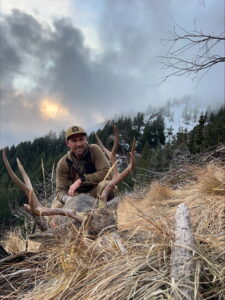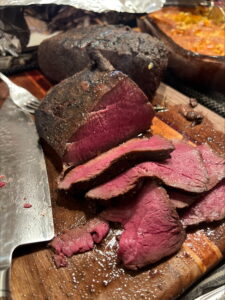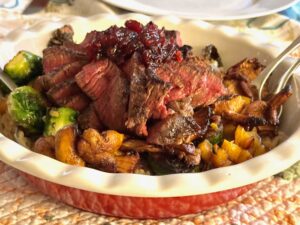From Field to Plate – Notes on Harvesting your Wild Game
Recently, our big game hunting expert and Managing Partner of Red’s Fly Shop, Joe Rotter, harvested a glorious buck which he shared with chef Davis! The two have come up with some tips for our avid hunter/chef readers on harvesting and cooking wild game. Read on, and please share your stories and recipes with us too!

From Joe…
Harvesting your own meat from a wild landscape is one of life’s greatest joys. There’s truly nothing like it. However, getting into deer hunting can feel intimidating, especially if you didn’t grow up in the woods or have never butchered your own meat. Over the years, I’ve heard countless people say, “I’d love to try hunting, but I wouldn’t know what to do if I got one.” I understand—it can seem overwhelming. But at its core, a harvested animal is simply pure, natural meat. And trust me, it’s the best.
Thankfully, we live in an age where resources are abundant. From videos to books, you can learn everything you need to know about processing wild game. There’s really no excuse. Get out there! Here are a few tips to help you get started:
- Master the kitchen and the field. Being a skilled chef and butcher is just as important as being a good hunter. Take time to study and practice so you’re prepared to turn your hard-earned harvest into high-quality, organic meals.
- Embrace the struggle. Statewide success rates for deer hunters hover around 15%. Most hunters don’t come home with a deer, but everyone enjoys the wild landscapes and the process. Fall in love with the adventure, the challenge, and the learning experience. If you stick with it, you’ll gain the skills to succeed.
- Trust the sign. Fresh tracks are just as good as spotting a deer—they’re proof you’re in the right place. Learn to read the landscape and trust the signs it gives you.
- Hunt the edges. Deer thrive in edge habitats where different ecosystems meet. Look for areas where timber, meadows, and riparian zones converge. These transitional zones are prime spots for deer activity.
- Read old books. Unlike much of today’s media, which often exists to sell products, older hunting books were written to share knowledge. As a kid, I devoured books about big game hunting, and the lessons I learned from those pages still guide me today.

Joe’s Roast Venison
From Chef Kevin Davis…..
If your deer was harvested optimally, e.g. you were lucky enough to make a clean shot, as well as the deer being properly dressed in the field, you can safely cook as you would a nice lean fillet of beef. Naturally, Kevin loves to use the backstrap, but he also loves the top round from the hind legs.
Chef’s favorite accompaniment is a tart sweet Agrodolce that he makes with fresh cranberries.

Kevin’s Pan Seared Venison with Cranberry Agrodolce and Roast Vegetables
4 6-8 ounce venison fillet
Salt and pepper
Agrodolce
1 cup sugar
Balsamic vinegar
2 teaspoons grated fresh ginger
Zest of 1 orange
2 cups fresh cranberries
¼ cup dates
1 teaspoon freshly ground black pepper
To serve
Roasted vegetables, such as Brussel sprouts, potato, kabocha squash, mushrooms
Method
- Season the venison and allow to come to room temperature.
- To make the agrodolce, place sugar in a large saucepan, and add enough balsamic vinegar to just dampen to a wet sand consistency. Simmer until soft ball stage – about 240 degrees F, then add grated ginger, orange zest, cranberries, chopped dates and pepper.
- Cook over medium heat until the cranberries have burst and the sauce is shiny.
- To cook the venison, pan sear on high heat to medium rare, rest 5 minutes, then slice and serve over vegetables. Spoon over sauce